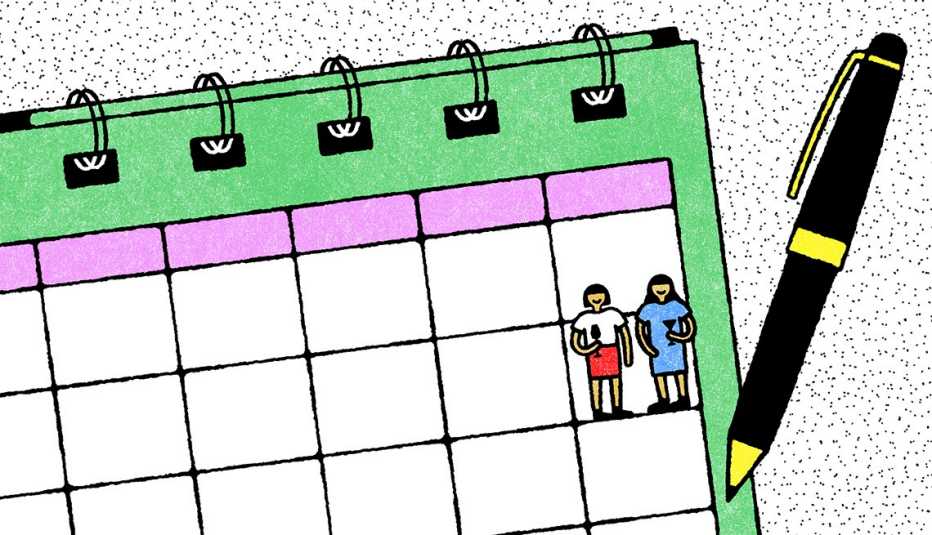AARP Hearing Center


Life can be messy and complicated, and ideally we’d all like to be more efficient and organized. Maybe you struggle with decluttering your home, keeping your calendar updated or scheduling time with friends. We’ve put together some practical day-to-day tips to help keep you on track. Plus, we included a few that will make your life easier in the future. When you’re done reading our helpful hacks, please share your own in the comments section at the bottom of the page.
1. Start your morning the evening before
Hectic days often start with hectic mornings. To make mornings smoother, start them the night before, suggests professional organizer Lindsey Mahanna, owner of Clutter to Clarity Home Organizing in Randolph, New Jersey. Premeasure your coffee for the week and set it aside in filters, ready to go. Each night, put a coffee-filled filter in the coffee maker and program it to brew before you wake up. This also works for smoothies — prep the ingredients the night before — or lunches: If you’re working, pack your lunch ahead of time. Pick out your outfit, set out your shoes. Make sure your bag or purse has everything you need and keys are ready to go. “Anything you can do the night before is going to make the next day easier,” Mahanna says.
2. Organize “like with like”
When it comes to saving time and simplifying tasks, even a small effort at home organization can make a big difference, according to professional organizer Stacey Agin Murray, owner of Organized Artistry in Fair Lawn, New Jersey. To get a handle on your possessions, she recommends arranging similar items together. “Grouping all baking products together in your cabinet helps you to know if you’re missing ingredients for your favorite cake,” Agin Murray says. “Grouping ‘like with like’ in your clothing closet saves you time and energy getting dressed in the morning. If you’re struggling to get organized … you’ll soon notice how easy it is to find what you need when you need it.” You can get as specific as you want — it might make sense to split your closet by season, or all short-sleeved shirts together, all T-shirts together, etc. If you don’t have a place for everything, you’ll need to create it. Every item in your home must have a home — and if you don’t have room, declutter to create it.
3. Rethink your workspaces
Store things where they’re actually needed, notes professional organizer and decorator Bonnie Borromeo Tomlinson, author of Stop Buying Bins & Other Blunt But Practical Advice From a Home Organizer. “Coffee mugs near the coffee maker. Hand towels near the sink. These might be obvious ones, but how many of you have your trash can positioned several feet away from your workstation, guaranteeing you will get debris on the floor moving from one location to the other? Moving it closer to where you need it creates less mess, time and effort,” she says.
4. Declutter regularly
Tackling clutter can feel overwhelming, so make it a routine and bite-size task, suggests professional organizer Elsa Elbert, founder and CEO of Composed Living, a Los Angeles–based organizing company. “Set time each week to declutter one small space in your home,” she says. “I recommend starting with a medicine cabinet or one category of clothing, such as coats. If you devote 15 minutes each week to eliminating items you no longer need, your home will look and feel wonderful in no time.” Also: Read our Smart Guide to Decluttering for tips on getting rid of what you don’t need.
5. Free up phone space
“Regularly declutter your digital devices, organizing files and deleting unnecessary apps and emails,” says time strategist and productivity consultant Jaimee Campanella of The Jaimee Campanella Company. “This not only frees up storage space, but also improves digital productivity and reduces distractions.” Digital photos, in particular, have a tendency to clog your phone’s arteries. “A quick and fun way to declutter those is to open the photos app each morning and type in today’s date without the year,” Elbert says. “You will enjoy seeing the memories, and also can delete any duplicates or photos that aren’t necessary at the same time. At the end of the year, you’ll be left only with photos you love, and more storage space on your phone.”


6. Be strategic about chores and errands
You can complete routine household chores and errands easier and faster by being more strategic, says Borromeo Tomlinson, who suggests taking your to-do list and reordering it for maximum efficiency. “If your day includes running errands and watering your garden, don’t water then do things around the house, then head out for the day. Combine them into one task by watering your garden as you leave the house to run errands since you are already outside,” she explains. “Let’s do another. When you are out running your errands, start with the location farthest from your home and work your way back, instead of hopscotching back and forth. … Likewise, add errands that are not time-sensitive to those days when you have appointments already, like getting gas on your way to a haircut appointment. That way, you are not making additional trips.”
7. Make a home inventory video
This is one tip that will take some work on the front-end, but will save you a big headache down the road. Once a year, walk through your home with your smartphone in hand and take video and photos of all your belongings, getting close enough to identify brands, models and serial numbers. Do this for both inside and outside your home — including the attic, garage, basement and shed. Doing so could save you a lot of time and money down the road in case household items are damaged or stolen. If that happens and you file a claim, your homeowners insurance policy will ask for a contents coverage, or a list of all items destroyed. This includes appliances, furniture, clothing, valuables, toys, electronics and tools. The amount covered typically is between 50 to 70 percent based on your policy, but could be higher depending on your situation. An extra step is to keep a record in your safe with receipts for high-dollar items. “Include all home systems, including HVAC heating and cooling units, hot water tanks and generators. These are often overlooked as many people don’t consider them personal property,” notes contractor Jay Sanders, owner of Castle Dream Construction, a home remodeling company in Baltimore, Maryland. Without an updated list, your insurance settlement will take a lot more time and not be nearly as accurate. If you want to lean on technology to make it more straightforward, there are a number of home inventory apps, including Sortly, Nest Egg and Encircle.
8. Hire a handyman to head off home hassles
Anyone who’s ever had a flooded basement or a broken furnace knows how complicated and time-consuming home-related headaches can be. An easy way to avoid them — and the life-altering chaos that ensues — is to hire a handyman at least once per year to make proactive repairs, says Sanders. “Preventative home maintenance is a great way to help make your life run smoother,” Sanders says. “Your handyman can check your homes’ filters; look for faulty hookups, wiring or plumbing; and they can help fix things that could be a bigger issue down the road.”
9. Install a dashcam
The next time you check in with your insurance agent to inquire about lowering costs, ask about dash cameras. Although most companies may not offer a discount for having a dash camera, it may save you money on a future claim. These devices, often called dashcams, record and save road activity in and outside of your vehicle. If you get into an accident or incident, footage from the camera can be sent to your insurance company to help resolve claims or accidents where fault is disputed. They also could help in claims that include vandalism and car theft. Many models can be installed without needing a second person or professional help, so select a model that you like based on your preferences.




































































You Might Also Like
Tips to Manage Your Stress
From scheduling stress and serenity to eating away the inflammation, here are ways to cope
How to Build Healthy Habits
These tips can help create changes that positively impact your well-being for years to come
Ways to Find a Sense of Purpose
Guidance to help you elevate your curiosity, plan your third act and expand your horizons
Recommended for You